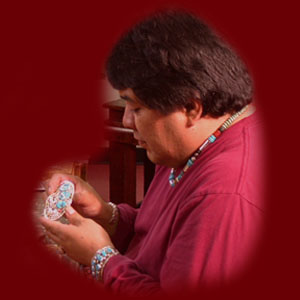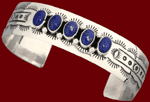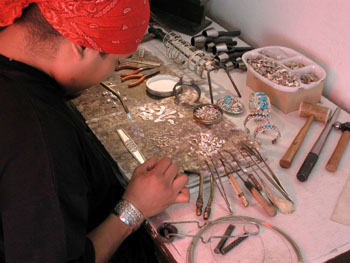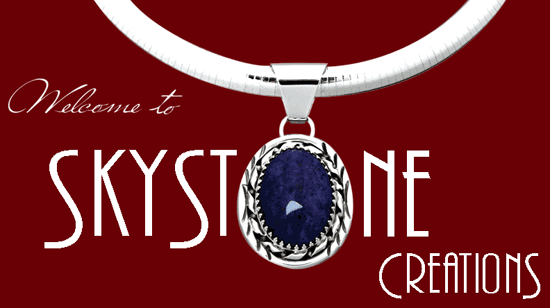| Skystone Creations is proud of the Navajo artists that are commissioned to create jewelry exclusively for us. When possible, we enjoy introducing visitors to our Arizona shop to the artist that crafted a favorite item. Navajo Jewelry : An Amalgam of Many Cultures The jewelry designs that have become the trademark of the Navajo silversmiths of the world are truly beautiful…. but borrowed. It is  believed that the Navajo were introduced to the seductive silver material in their interactions with the Plains Indians. Gifts of sterling silver jewelry trinkets were abundantly bestowed on the native Plains Indian tribes by the French British, and Colonial military forces vying for territorial control of the new frontier. Further, the Navajo adopted the designs and craftsmanship from the Pueblo Indians, the Spaniards, and the Mexicans. From the Anglos came the market. From the Navajo soul came the ability to blend them all in a beautiful experience. believed that the Navajo were introduced to the seductive silver material in their interactions with the Plains Indians. Gifts of sterling silver jewelry trinkets were abundantly bestowed on the native Plains Indian tribes by the French British, and Colonial military forces vying for territorial control of the new frontier. Further, the Navajo adopted the designs and craftsmanship from the Pueblo Indians, the Spaniards, and the Mexicans. From the Anglos came the market. From the Navajo soul came the ability to blend them all in a beautiful experience.
Navajo jewelry emphasizes movement. It is an exploration of form and the artist's desire to express beauty. The Navajo experiences beauty through expression, not through perception of what is deemed to be beautiful. Beauty is experienced, but never possessed. For beauty, and the expression of beauty to be maintained, it needs to be renewed in all aspects of Navajo living -in art, song, dress, and daily living.
For more on Navajo culture, click on one of the following links below.
Navajo Jewelry: An Evolution of Design Tied to Tools and Technology
The Navajo who migrated to the Southwest 200 years ago carried very little cultural baggage, and proved to be highly adaptive and inventive people. They were quick to synthesize and weave the divergent customs, practices, and techniques of seemingly opposite cultures into their own history. At the same time, they maintained the Navajo sense of harmony and flow. 
The early phase Navajo jewelry reflects the design preferences of the Plains Indians whose sterling silver jewelry pieces were less massive than what has become known as Navajo style .Early Navajo work of this period incorporates the flat surfaced and the bangle style. The designs of early pieces were also restricted by the crudeness of the wood and stone tools used. Some were decorated with simple patterns with a cold chisel before the use of solder. For more on the Plains Indians, click on one of the following links below.
 As the techniques were refined and the silver supply became more abundant, by 1875, Navajo silver work moved into the middle phase characterized by more massive and ornamental pieces, for which the Navajo culture is now noted. To produce these more complex expressions, the Navajo had acquired the technique of forge soldering that allowed them to join one piece of silver to another. About the same time, the Navajo also began to produce their own ingots which could be hammered into bar bracelets that expanded the surface and, therefore, the opportunity for ornamentation. The middle phase is simply a continuum of the advancing technological skill of the Indian artists. It is marked by greater elaboration of design. As the techniques were refined and the silver supply became more abundant, by 1875, Navajo silver work moved into the middle phase characterized by more massive and ornamental pieces, for which the Navajo culture is now noted. To produce these more complex expressions, the Navajo had acquired the technique of forge soldering that allowed them to join one piece of silver to another. About the same time, the Navajo also began to produce their own ingots which could be hammered into bar bracelets that expanded the surface and, therefore, the opportunity for ornamentation. The middle phase is simply a continuum of the advancing technological skill of the Indian artists. It is marked by greater elaboration of design.
The later phase of the last few decades is marked by streamlined designs. The modern day concha belt is a prime example of the Navajo's continued synthesis of divergent cultures and elements. Round disks of the concha belt were used as hair ornaments by Eastern tribes, such as the Plains Indians who attached German silver disks to belts. To add flair to the contemporary Navajo designs, the artists often added a Spanish element reflected in a richer relief and more exploratory ornamentation. The concha belts displayed a personal "wealth" which reflected social position earned through demonstrated abilities and responsibilities and not inherited position.
For more information on the history of Navajo Indian Jewelry, please visit our history page below. | 
 believed that the Navajo were introduced to the seductive silver material in their interactions with the Plains Indians. Gifts of sterling silver jewelry trinkets were abundantly bestowed on the native Plains Indian tribes by the French British, and Colonial military forces vying for territorial control of the new frontier. Further, the Navajo adopted the designs and craftsmanship from the Pueblo Indians, the Spaniards, and the Mexicans. From the Anglos came the market. From the Navajo soul came the ability to blend them all in a beautiful experience.
believed that the Navajo were introduced to the seductive silver material in their interactions with the Plains Indians. Gifts of sterling silver jewelry trinkets were abundantly bestowed on the native Plains Indian tribes by the French British, and Colonial military forces vying for territorial control of the new frontier. Further, the Navajo adopted the designs and craftsmanship from the Pueblo Indians, the Spaniards, and the Mexicans. From the Anglos came the market. From the Navajo soul came the ability to blend them all in a beautiful experience.
 As the techniques were refined and the silver supply became more abundant, by 1875, Navajo silver work moved into the middle phase characterized by more massive and ornamental pieces, for which the Navajo culture is now noted. To produce these more complex expressions, the Navajo had acquired the technique of forge soldering that allowed them to join one piece of silver to another. About the same time, the Navajo also began to produce their own ingots which could be hammered into bar bracelets that expanded the surface and, therefore, the opportunity for ornamentation. The middle phase is simply a continuum of the advancing technological skill of the Indian artists. It is marked by greater elaboration of design.
As the techniques were refined and the silver supply became more abundant, by 1875, Navajo silver work moved into the middle phase characterized by more massive and ornamental pieces, for which the Navajo culture is now noted. To produce these more complex expressions, the Navajo had acquired the technique of forge soldering that allowed them to join one piece of silver to another. About the same time, the Navajo also began to produce their own ingots which could be hammered into bar bracelets that expanded the surface and, therefore, the opportunity for ornamentation. The middle phase is simply a continuum of the advancing technological skill of the Indian artists. It is marked by greater elaboration of design.